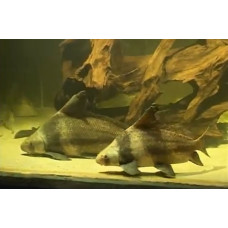Catostomidae is a family of fishes in the order Cypriniformes. They are distinguished from other carp fishes by their multiciliated, single-row pharyngeal teeth, and the absence of a miller. There are no antennae. The family consists of 70 species and 14 genera. Freshwater fish. Found in the waters of North America, northeastern Siberia and China. Spawns in spring, after the rivers open, on rocky bottoms. Matures at the age of 5-6 years. Fecundity is 17.5-60 thousand eggs. It feeds on bottom-dwelling organisms, higher aquatic vegetation and algae. Not commercially important.
The Catostomidae are similar in appearance to the Carpidae and are thought to be descended from them. Catostomidae can be distinguished by their thick, tufted lips. These fish never have whiskers, the beak is absent and the body is always covered with highly visible scales.
The Catostomidae can be divided into two groups. The first are tall fishes with long, thin lower pharyngeal bones, small frequent pharyngeal teeth, relatively long and frequent gill stamens. They are mainly found in the lower reaches of rivers. They feed on small invertebrates, sometimes vegetation, and are quite large. Ictiobus cyprinellus reaches a length of 120 cm; Carpiodes surpinus, characterised by a long, flagpole-like second ray of the dorsal fin, reaches a length of more than 65 cm and a weight of more than 5 kg. The second group includes fish with elongated, spindle-shaped bodies, shorter lower pharyngeal bones and stronger pharyngeal teeth. The gill rakers are shorter and more sparse. These species inhabit mostly swift rivers and feed on benthic invertebrates. Fish in this group are smaller, with the largest species reaching 60 cm.
All Catostomidae lay bottom eggs. Some spawn in swift currents and on rocky bottoms, while others spawn in quiet places, often on vegetation. Spawning occurs in spring and the first half of summer. Males are generally smaller than females. During spawning they have a mating display of lighter colouring and horned tubercles - "pearl rash". Some have tubercles only on the head, while others have them on the body in the form of separate islands or grouped in several rows. This probably depends on the spawning behaviour of the fish and the environmental conditions. The fecundity of Catostomidae living in rivers is lower than that of lake fish. Catostomus catostomus inhabits the waters of the Arctic Ocean basin in eastern Siberia from Indigirka eastward and throughout North America, in the Bering Sea basin to the Anadyr River. In Siberian rivers it forms the Siberian subspecies (C. catostomus rostratus). It lives in fast rivers with rocky bottoms. It reaches a length of 60 cm. Males smaller than females. Matures at 5-6 years of age. Spawns in May-June. Eggs are quite large, about 2 mm in diameter. The males have small epithelial tubercles on the rays of the anal fin. Juveniles feed on small invertebrates and diatoms, while adults feed on larger benthos.
Catostomidae
Tags: catostomidae



